
The Kawai Green Hobby Diorama series includes seeds and nutrients for
a small patch of green sprouts to grow.
This is KG.01, 1/100 scale traditional Japanese farmer's house.
|
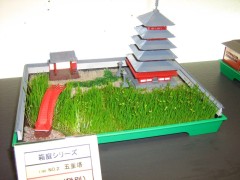
The KG.02 features the Gojyuunotou, a five story pagoda done in 1/250
scale.
|
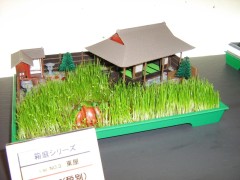
The KG.03 Tea House (Annex.)
This one is 1/60 scale.
|
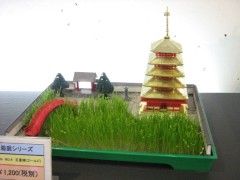
I believe the KG.04 is the same as the KG.02 but the sprue for the
parts for the roof is molded with gold colored plastic.
I'm not sure if it is chromed or not.
|
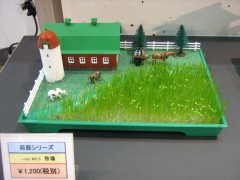
KG.05 Ranch. The scale is 1/250, but I'm not so sure...
|
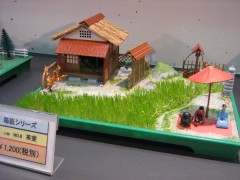
KG.06 Tea House (Field Spot) done in 1/60 scale.
|
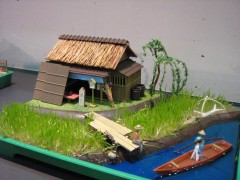
KG.07 recreates a scene of a river crossing point. The scale
is 1/60.
|
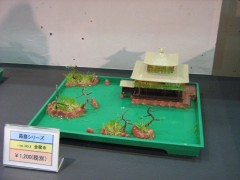
The KG.08 Kinkakuji (a.k.a. The Temple of the Golden Pavailion) is
in 1/200 scale.
|
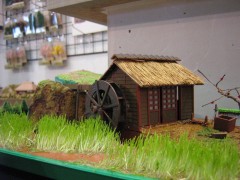
KG.09 recreates a water mill.
The scale is 1/60.
|
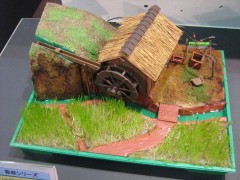
Here's an overhead shot of KG.08.
|
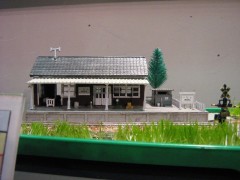
With KG.10, Kawai presents an old fashion rural train station.
The scale is 1/150.
|
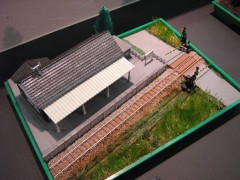
An overhead shot of KG.10.
The rail crossing warning lights are typical of post 1960's.
|
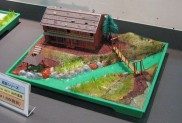
KG.11 is a mountainside hot spring tavern. The scale is 1/150.
|
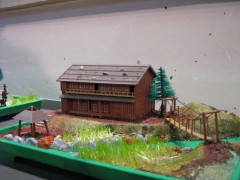
The small roofed structure in the lower left is the open air hot spring.
|
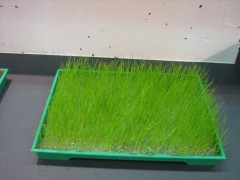
You can buy the seed matts seperately from Kawai. According to
the catalog, the seeds will sprout in a matter of days and provide green
for 50 days if watered at the right level.
|
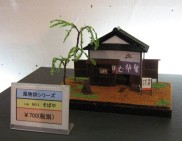
Kawai also has different building series titled the Seasonal Scene
Series.
Here's KF.01 The Shoba Shop.
The scale is in 1/60.
|
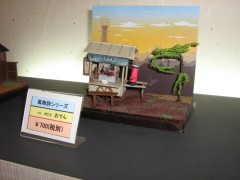
KF.02, the Oden Stand.
Oden is a type of Japanese cooking where various foods (boiled eggs,
white radish slices, various meats, fish paste cakes, etc.) are simmered
in a broth of soy souse, vinger, and bonito fish flavorings. Keeps
you nice and warm through those colder months.
This one is in 1/25 scale.
|
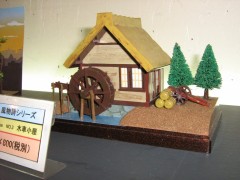
KF.03 is another water mill. This one is also in 1/60 scale.
|
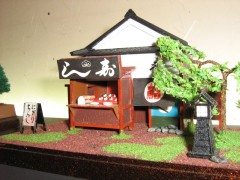
KF.04 is an old style sushi store. You don't see store fronts
like these anymore unless you go to areas like Kyoto where old cityscapes
have been preserved.
The scale is 1/60.
|
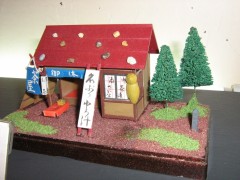
KF.05 is a traditional green tea cafe. This type of store front
is more common in the pre-war era and more often seen in rural setting
and mountain roads.
The scale is 1/60.
|
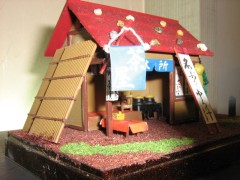
Another shot of KF.05.
The stones on the roof are to keep the roof from flying off during
days when the wind is strong.
|
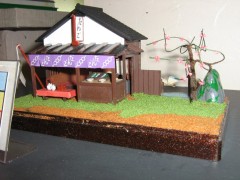
KF.06 is a dango shop. Dango's are sweet rice cake balls on a
stick. Usually three to a stick. This is also in 1/60 and more
typical of pre 1950's Japan.
|
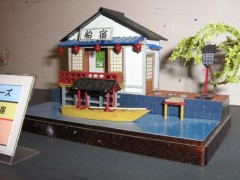
KF.07 is a lodging for boat bound people. Since travel on boats
took much longer in the old days, people would stay at lodging such as
these during the night. People enjoying fishing would also use places
like this to rest up.
The scale is 1/60.
|
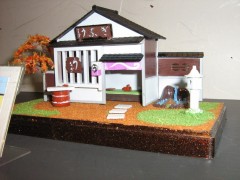
KF.08 is a broiled eel restaurant.
Unfortunately, many of these building have no depth whatsoever, so
in many case you only have a store front facade to work with.
The scale again is 1/60.
|
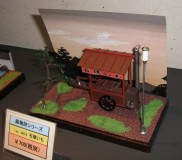
KF.09 is a Hot Yam Stand.
During winter months, you see these carts traveling through the streets
and calling out their business.
Most Ishiyaki Imo stands now are small pick-up trucks, however.
Scale is 1/25.
|
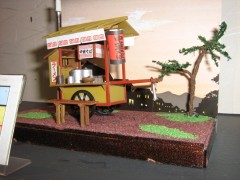
KF.10 is a 1/25 scale representation of a soba / ramen stand.
Ramen is sometimes referred to as "Chinese Soba" so sometimes they go by
different names.
Just to let you know, soba is buckwheat noodles, ramen is egg noodles,
and udon is regular wheat noodles.
|
For some reason, kit number KF.11 "Traditional Rice Bowl Food Stop"
was missing.
|
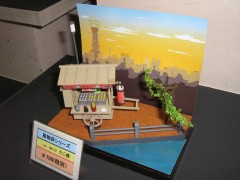
KF.12 is a hot squid ball stand/cart.
The scale is in 1/25.
|
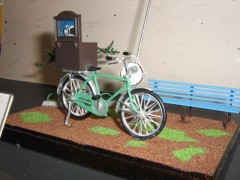
Here's KF.13, the Kamishibai bike setup.
Kamishibai was a form of entertainment where storys are retold with
a mixture of visuals provided by the color plates seen on the rear bike
stand and audio provided by the storyteller. The storyteller would
change the panels as the story progressed. Kids were encouraged to
buy sweets and snacks from the storyteller before the narrative would start.
Obviously, the advent of the TV and the rapid availability of food stuffs
from the late 1950's pretty much killed off this business model, but the
traditions of kamishibai can still be enjoyed at special presentations
conducted at various public venues.
The scale is 1/25.
|
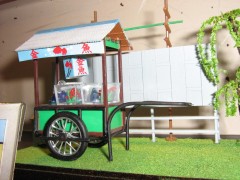
KF.14, the gold fish stand.
Scale is in 1/25.
Not at all common these days.
|
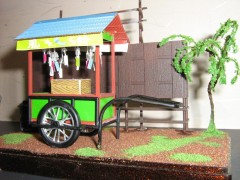
KF.15, the wind chime stand.
You can still catch sight of these stands during the early months of
summer even today.
The scale is 1/25.
|
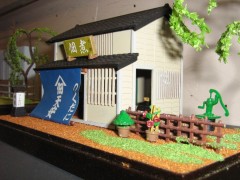
KF.16 tsukudani preserves foodstore. Tsukudani is any food that's
been boiled down into a semi-paste form using soy sauce as the main preservative.
The scale of this kit is 1/60.
|
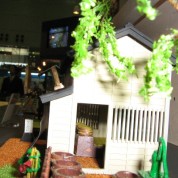
Here's side view of KF.16. The store in this kit does have some
depth, for a change. I'd think converting this store into a generic
traditional style Japanese building would not be too difficult.
|
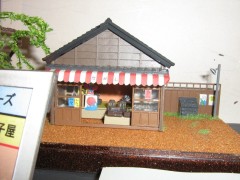
KF.17, the dagashiya. Dagashiya's are like dime stores, snake
stands, or a kiosk. It's the store where kids hang out and buy snakes
and toys and play games. Many dagashiya's suffered as arcade games
started expanding business and game centers became places where kids spent
more of their time. Convenience stores and home console video games
pretty much sealed the fate of dagashiya's. There are hardly no dagashiya's
in operation in the neighborhoods in Tokyo today.
The scale of this kit is 1/60.
|
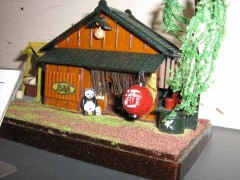
KF.18 is an old style eatery/bar called izakaya. Izakaya's are
all the rage today in Japan, but few have store fronts like this anymore.
The scale for this kit is 1/60.
|
For some reason, kit number KF.19 Theater House was missing.
Kawai was announcing that KF.20 will be released soon. KF.20
will be Old Style Japanese Bath House.
|